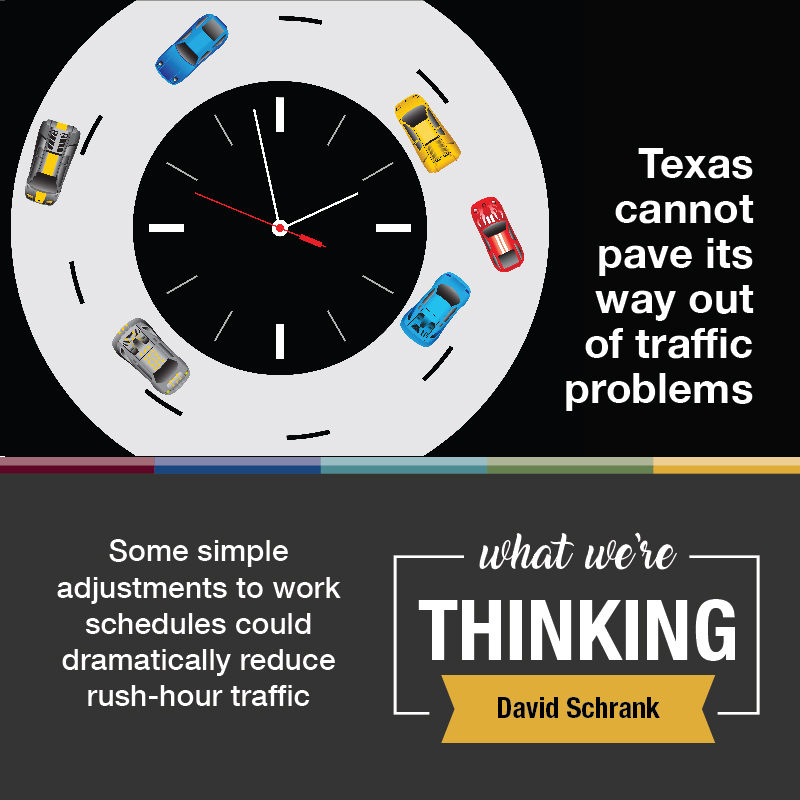 Some simple adjustments to work schedules could dramatically reduce rush-hour traffic
Some simple adjustments to work schedules could dramatically reduce rush-hour traffic
By David Schrank
When we drive to work, we’re more than just commuters; we’re data points in a daily test of the laws of supply and demand. And the result is the same every day. The roadway space we want exceeds the space we have. Federal, state and local agencies have for decades responded primarily with more roadway lane miles. Since demand is likely to grow, now would be a good time to expand our thinking beyond supply-side solutions and talk about a different, demand-side approach.
We can take a big bite out of our growing gridlock dilemma, illustrated by the 2019 Urban Mobility Report, without adding a lot of lane miles, (though we’ll still need some new roadways to address growth and maintenance.) We can do that by reducing the number of cars at the busiest travel times. Transportation professionals call this travel demand management, or TDM.
TDM got a lot of attention in the 1970s and 1980s, when high oil prices and long lines at gas stations created a sense of urgency about transportation challenges. Rather than feeling a financial constraint imposed by an energy crisis like decades ago, commuters today are feeling squeezed for time. With that in mind, TDM is an old concept worthy of new effort, and it includes some very simple and doable ideas.
With compressed work weeks, many workers can deliver 40 hours of productivity in four days instead of five, once a week letting their cars take up space in a driveway rather than a freeway. With flex time, they can shift the workday by an hour or two earlier or later, and effectively spread out the peak travel period so traffic moves more quickly and smoothly. With telecommuting, an expanding number of jobs of many kinds can be done from alternate work sites instead of a central office location. Not all jobs can be done remotely, of course, but for the cost of laptop computers, quite a few of them can be.
There are many other TDM strategies, but those I’ve mentioned are the simplest and easiest for employers, in both public and private sectors, to implement. By redefining where and when the week should be done, we can start to reduce travel demand almost immediately.
In fact, taking just one out of 10 cars off the roads during rush hour would make a noteworthy difference. We know because the Texas A&M Transportation Institute studied this effect by comparing typical workday traffic in Austin to state government holidays (when state employees, about 8 percent of the region’s workers and 19 percent of central Austin workers, are not commuting). Our analysis of traffic patterns showed a noticeable reduction on those holidays, suggesting that state agency (or any other large employer) work hour commuting policies can positively influence congestion through programs that alter travel patterns.
This is different thinking, of course, which requires all parties to be part of the discussion. It’s important for employers to be active in addressing our mobility problems, because our transportation network is vital to continued business productivity and economic prosperity.
We simply cannot asphalt-and-concrete our way out of our cascading traffic problem, so attacking it from the demand side makes abundant sense for three big reasons:
- We know it will work (because we did the research).
- We could see results almost immediately (we wouldn’t have to wait on a road project that would take years to complete).
- It’s a lot cheaper than building more roadway space (a single lane mile of freeway can cost millions; if we could redirect that investment in other ways, just imagine how many laptops you could buy with that much cash.)
If we had always planned our transportation future based on what was familiar, the saddle and horse carriage industries would be dominant players in today’s economy. Large-animal veterinarians would have guaranteed job security. And, we’d also have an astonishing amount of manure to contend with.
Thankfully, we didn’t take that path. We chose to not cling to an old mobility idea just because it had worked in the past. We should apply the same forward-thinking approach to today’s mobility needs, concentrating more on how to use our roads better, not just on how to build more of them.
This article was originally published in The Dallas Morning News, January 26, 2020.
David Schrank is a senior research scientist at the Texas A&M Transportation Institute.